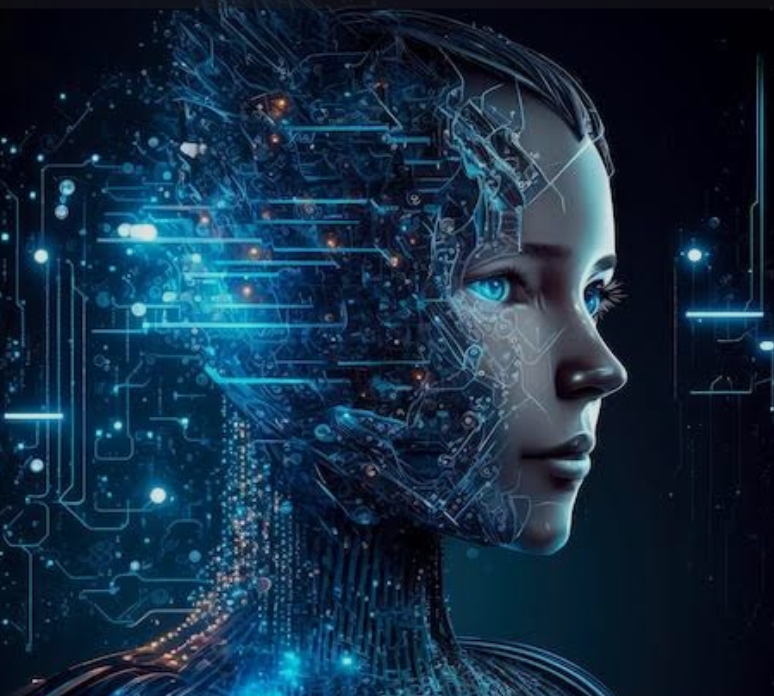Artificial intelligence, or AI, is super smart computer stuff that has changed how we do things. Now, it’s also making a big impact on how computers talk to us.
Imagine computer-made characters that look and act like people – those are AI avatars. And some of them can even talk! These talking avatars are getting good at having conversations that feel personal and real.
People are using these talking avatars in lots of areas like helping customers, teaching, entertaining, and advertising. They’re becoming more and more like us because the technology behind them is getting better. That means they can talk, understand language, and even show emotions on their computer-generated faces. It’s cool!
A 2020 report by Gartner predicts that by 2023, 75% of enterprise interactions will be conducted with AI chatbots.
And I guess it is happening Right Now!
Evolution of AI Talking Avatars
A long time ago, when computers were just starting to get fancy, people began thinking about computer characters that could talk like us. At first, these talking computer characters were not very good and could do only a few things. But as time went on, smart people made them much better and more like real people. So, now we have smart computer characters that can talk to us in a way that seems real.
Key Technological Advancements
Several technological advancements have contributed to the evolution of AI talking avatars.
Natural Language Processing (NLP):
Imagine if the computer characters could understand and talk to us in a way that feels normal, like chatting with a friend. NLP is the computer magic that helps them do that. It makes the computer characters smart enough to understand human language and respond in a way that makes sense.
Speech Synthesis:
Have you ever heard a computer talk and it sounded a bit weird? Speech synthesis is the tech that makes computer characters sound more like real people when they talk. It’s like giving them a human-like voice so that the conversation feels natural and not robotic.
Facial Animation:
When you talk to someone, you see their face and expressions, right? Well, facial animation is like giving computer characters a face that can show feelings. It makes the avatars look and act more like us by allowing them to smile, frown, or show other emotions. This makes the conversation more interesting and relatable.
So, these three things are the cool tricks that make AI talking avatars seem so real and engaging!
Milestones and Breakthroughs in the Field
The development of AI talking avatars has witnessed several notable milestones and breakthroughs.
The First Talking Avatar in the 1970s:
Way back in the 1970s, smart people made the very first talking computer character. It was a big deal because, for the first time, a computer could talk like a person!
Improved NLP and Speech Synthesis Algorithms:
Over time, super smart people made the talking computer characters even better. They upgraded the computer’s understanding of language (NLP) and the way it talks (speech synthesis). This made the conversations more natural and easier to understand.
Real-Time Facial Animation Techniques:
Imagine if the computer characters could show emotions on their faces, just like we do. Well, some geniuses figured out how to make that happen. They created tricks so that the computer characters can move their faces in real time, making them look more alive and expressive.
So, it all started with a talking computer in the ’70s and got better and better from there!
Current Applications of AI Talking Avatars
AI talking avatars are being used in a wide range of applications across different industries. DeepBrain provides AI Talking Avatars that can be utilised in all these applications.
Customer Service and Virtual Assistants
Imagine if you could talk to a computer anytime you have a question or need help. That’s what’s happening in customer service! AI talking avatars are like 24/7 helpers on websites, answering your questions in a friendly and natural way.
Integration into E-learning Platforms
When you’re learning on the computer, it can sometimes feel a bit lonely, right? Well, AI talking avatars are changing that. They’re like virtual teachers or guides on e-learning websites, making learning more fun and personal, like having a study buddy on your computer.
Entertainment and Gaming Industry
Do you like playing video games? AI talking avatars are making games even cooler! They can be characters in the game, hosts, or even personalized friends for gamers. It’s like the characters in the game can talk to you and make the experience more exciting and special.
Social Media and Marketing
Social media is a big part of how we connect with others, right? Well, now AI talking avatars are joining in! They can represent brands, talk about products, or even be like virtual social media stars. It’s a fun way for companies to connect with us in a more interactive and interesting way.
The Technological Landscape
Natural Language Processing (NLP)
NLP is like the brains behind AI talking avatars. It helps them understand what we’re saying and respond in a way that makes sense. Thanks to improvements in NLP, these avatars can now understand complex sentences, have meaningful conversations, and adjust their responses based on the situation.
Voice Synthesis and Generation Technologies
Have you heard computer talk and it sounds a bit off? Voice synthesis and generation technologies fix that! They’re like the vocal cords for AI talking avatars, making their speech sound more natural and interesting. These technologies have become smart, capturing things like emotions and accents.
Machine Learning Algorithms
Imagine if the avatars could learn and get better over time. That’s where machine learning comes in. It helps them improve how they talk by learning from speech data, understand emotions by analyzing facial expressions, and adapt their responses based on how we interact with them.
Neural Networks
Neural networks are like the super brains of AI. They’ve changed the game, making AI talking avatars look and act more like us. These networks can handle a lot of information to learn complex things like detailed facial expressions, body movements, and how to talk in a way that feels real.
In simple terms, these technologies are the reason AI talking avatars can talk like us, understand what we’re saying, and even express themselves with emotions and movements.
Feels like giving computers a bit of human touch!
Challenges and Considerations
Think of the uncanny valley like this: when something that’s supposed to look like a human, like those AI talking avatars, gets close to looking real but not quite, it can feel a bit weird. It’s like they’re almost like us, but not quite, and that can be unsettling.
Making AI talking avatars look real while still feeling friendly and relatable is tricky. It’s like finding the right mix between making them look like us without making us feel uncomfortable.
Sometimes, these talking avatars need to know more about us to chat better. But collecting and using our personal info brings up worries about privacy. It’s crucial to make sure our data is protected, and companies should be clear about how they use it.
Just like any cool tech, there’s a chance it could be used for not-so-good things. AI talking avatars might be misused to spread lies, play with our feelings, or even pretend to be real people. To stop this, we need rules and guidelines to make sure they’re used the right way.
As these talking avatars become more common, it’s important to have rules and standards, like the ones we have for other things. These rules should cover stuff like keeping our data safe, being fair and honest, and making sure these avatars are used in ways that help, not harm.
Future Trends in AI Talking Avatars
Enhanced Personalization and Customization
In the future, talking computer characters will get even better at knowing what each person likes. They’ll remember how we prefer to chat, what we enjoy, and even understand our feelings, so the conversations feel just right for each of us.
Integration of Emotional Intelligence in Avatars
Imagine if the computer characters could understand how you feel and respond accordingly. Well, that’s what might happen! These talking avatars will become smarter about recognizing and understanding our emotions, making the conversations more like talking to a real person who understands us.
Cross-Platform Compatibility and Interoperability
Soon, these talking avatars won’t be limited to just one type of device. They’ll work smoothly on different gadgets and in various places. So, whether you’re chatting on your computer, phone, or even a smart fridge, the talking avatar experience will be consistent and feel familiar.
Collaboration with Other Emerging Technologies (AR, VR)
Picture this: talking computer characters not just on screens but in virtual and augmented reality worlds. In the future, these avatars will team up with cool technologies like virtual reality (VR) and augmented reality (AR). This means we might have conversations with them in a digital world, making things super interactive and immersive.
Challenges Faced by Industries in Adopting This Technology
Industries face various challenges in adopting AI talking avatar technology.
Technical Complexity and Integration
Getting these talking computer characters to work with the systems that are already in place can be like solving a tricky puzzle. It requires smart people who understand a lot about technology.
Data Privacy and Security
When these talking avatars learn about us to have better conversations, it’s important to keep that information safe. Just like we lock our doors for privacy, companies need to make sure our data is secure.
Cost and Resource Requirements
Making and keeping these talking avatars running smoothly can be expensive. It’s like buying and taking care of a high-tech gadget. Companies need to spend money and allocate resources to make sure everything works well.
User Experience and Human-Computer Interaction
Making sure AI talking avatars are successful means they have to be easy and pleasant to use. They should be simple to talk to, respond in a natural way, and not make users feel frustrated or confused.
Impact on Human-Computer Interaction
Talking computer friends are changing how we talk to machines. They make it feel more like talking to a person, making the conversations fun and personal. They can foster emotional connections and enhance engagement.
User Acceptance and Feedback
To make computer friends better, it’s important to listen to what people think. Developers can ask questions and get opinions from users through surveys and testing. This helps them make computer friends even more awesome and match what people want.
Potential Disruptions and Opportunities
Talking computer friends can make a big difference in different areas, like:
- Customer service: They can help you anytime, answering questions and fixing problems to make customers happy.
- Education: These computer friends can be like virtual teachers, helping you learn in a way that suits you and making studying more fun.
- Entertainment and gaming: In games and fun stuff, these computer friends can make things more exciting. They can tell stories, guide you in games, and keep you interested.
Disruptions in Traditional Communication Channels
Talking computer friends are changing how we talk to businesses and people. They can take the place of old-fashioned customer service phones, help with online shopping, and even be hosts for events and meetings.
Looks like it’s a new way of chatting and getting things done!
Opportunities for Innovation
Computer friends that talk open chances for new and creative ways of doing business. Companies can create smart talking computer solutions for different jobs, making services personalized, getting customers more interested, and finding new ways to make money.
Conclusion
The talking computer friends we have now are a big step forward in how we talk to machines. They can change lots of jobs, make things more personal and fun, and even shake up how we usually communicate.
Looking ahead, these talking computer friends will keep getting better. Technology will keep improving, more people will like using them, and they’ll be used in even more jobs. Soon, they’ll be super smart, more personalized, and part of our everyday lives, making the digital world feel like the real one.
The people who make and study these talking computer friends are important. Businesses can use them to make their work better, and researchers can keep making them smarter and easier for us to use. Working together, they can make these talking computer friends even more amazing, changing how we talk to machines and making different jobs even cooler.
















